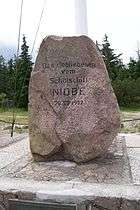Niobe (schooner)
 | |
| History | |
|---|---|
| Name: | Niobe |
| Namesake: | Niobe |
| Builder: | Frederikshavns Værft og Flydedok[1] |
| Launched: | 2 August 1913[2] |
| In service: | 30 April 1923[2] |
| Captured: | 21 November 1916 |
| Fate: | sunk 26 July 1932 off Fehmarn[2] |
| General characteristics | |
| Class and type: | training vessel |
| Displacement: | 645 t (635 long tons)[1] |
| Length: | 46.1 m (151 ft 3 in)[1] |
| Beam: | 9.17 m (30 ft 1 in)[1] |
| Draught: | 5.2 m (17 ft 1 in)[1] |
| Propulsion: | 1 Bolinder 2-cylinder two-stroke engine of 160 shp (120 kW)[1] |
| Sail plan: | 943 m2 (10,150 sq ft)+40 m2 (430 sq ft)[1] |
| Speed: | 7.5 knots (13.9 km/h; 8.6 mph)[1] |
| Complement: | 7 officers, 27 men, and up to 65 cadets[1] |
The Segelschulschiff Niobe was a tall ship used by the Reichsmarine to train cadets and aspiring NCOs. She sank during a white squall on 26 July 1932, with the loss of 69 lives. At Gammendorfer Strand on Fehmarn island, within view of the site of the sinking, the Niobe-Denkmal monument was erected.
Construction

She was built as a four-masted schooner in 1913 by the Danish shipyard Frederikshavns Værft og Flydedok under her original name Morten Jensen and initially sailed as a freighter for F. L. Knakkergaard in Nykøbing Mors. In 1916 she was sold to Norway and renamed Tyholm.
Later that year, while carrying mine timber to England, she was taken as a prize by SM UB-41 and sold to private German owners. Following several intermediate phases under various names (Aldebaran, Niobe, and Schwalbe), including one as a charter ship for a film company, she was purchased in 1922 by the German navy which selected her new name Niobe after the mythological daughter of Tantalus, and converted her into a three-mast barque to train future officers and non-commissioned officers. The previous training vessels, Grossherzog Friedrich August and Prinzess Eitel Friedrich, had been seized by the Allies as war reparations.

In a white squall on 26 July 1932, the ship capsized near the German island of Fehmarn in the Baltic Sea (54°35.7′N 11°11.2′E / 54.5950°N 11.1867°ECoordinates: 54°35.7′N 11°11.2′E / 54.5950°N 11.1867°E)[3] and sank within minutes as due to the hot weather, all hatches and portholes were open. 40 of her crew were rescued by the cargo ship SS Theresia L M Russ, but 69 died. The ship was raised on 21 August 1932, towed to Kiel and inspected while the bodies were buried. On 18 September 1933 the wreck was ceremonially sunk by the torpedo boat Jaguar, attended by much of the then-small German navy.
Design
The ship had a steel hull and displaced 645 tonnes. After her conversion into a training ship she measured 57.8 m (189 ft 8 in) in overall length, 46.1 m (151 ft 3 in) without the bowsprit, and 9.17 m (30 ft 1 in) in width. The height of the main mast was 34.8 m (114 ft 2 in), and she carried 15 sails with 983 square metres (10,580 sq ft) of total sail area. She had an auxiliary diesel engine with 160 shaft horsepower (120 kW). Her regular crew comprised seven officers and 27 men. Usually 65 cadets would be trained.
References
- Notes
- Bibliography
- Koop, Gerhard (1998). Die deutschen Segelschulschiffe. Bonn: Bernard & Graefe Verlag.
- Busch, Fritz Otto (1932). Niobe. Ein deutsches Schicksal. Leipzig: Breitkopf & Härtel.
- Bölk, Walter; Landschof, Erich (1988). Schiffe in Not. Strandungen und Seeunfälle um Fehmarn 1857-1987. Rendsburg: Verlag Heinrich Möller Söhne. ISBN 3-87550-090-3.
- Gröner, Erich (1988). Hilfsschiffe II: Lazarettschiffe, Wohnschiffe, Schulschiffe, Forschungsfahrzeuge, Hafenbetriebsfahrzeuge (I). Die deutschen Kriegsschiffe, 1815-1945. V. Koblenz: Bernard&Graefe. ISBN 3763748040.